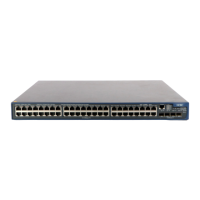4-47
Use the undo router id command to cancel the router ID that has been set.
If the router-id command is not used, a router ID is set following these rules:
z If loopback interfaces configured with IP addresses exist, the greatest loopback interface IP
address will be used as the router ID.
z If no loopback interface IP address exists, the greatest IP address of other interfaces will be used
as the router ID, regardless of whether the interfaces are up or down.
z A new router ID is selected only after the existing router ID is deleted or modified. Other cases, for
example, when the interface with the router ID goes down, when a loopback interface address is
configured after a non-loopback interface address is selected as the router ID, or when a greater
interface IP address is configured, cannot trigger a new router ID selection process,
z To validate a new router ID, you need to execute the reset command.
Related commands: ospf.
Examples
# Set the router ID to 10.1.1.3.
<Sysname> system-view
System View: return to User View with Ctrl+Z.
[Sysname] router id 10.1.1.3
silent-interface
Syntax
silent-interface silent-interface-type silent-interface-number
undo silent-interface silent-interface-type silent-interface-number
View
OSPF view
Parameters
silent-interface-type: Interface type
silent-interface-number: Interface number.
Description
Use the silent-interface command to disable an interface from transmitting OSPF packet.
Use the undo silent-interface command to restore the default.
By default, the interface is enabled to transmit OSPF packet.
To prevent the router on some network from receiving the OSPF routing information, you can use this
command to disable this interface from transmitting OSPF packet. On the switch, this command can be
used to enable/disable OSPF packet transmission through the specified VLAN interface.

